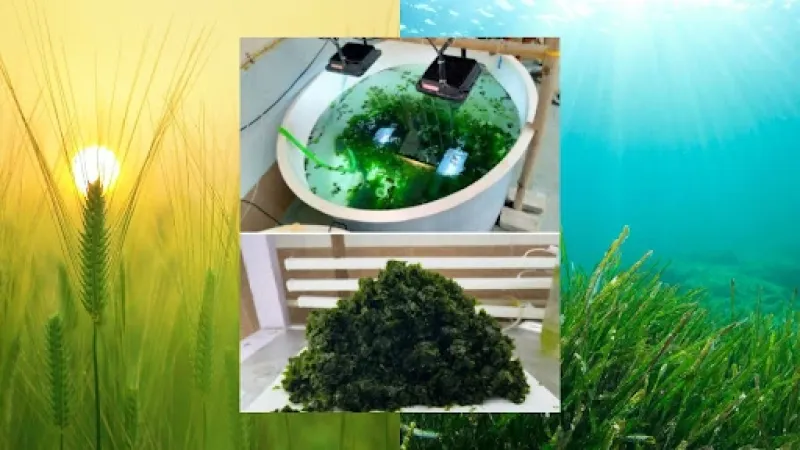
Around 50% of habitable land around the world is used for agriculture. In the process, we have destroyed forests, hills, and valleys, and continue to do so to feed an ever-growing population. India, the world's most populous nation, with an estimated 1.4 billion people, also has around 50% of its land dedicated to farming. Yet, the country is also facing freshwater shortages and erratic agricultural output, in part due to climate change. Despite large-scale agriculture, India is ranked 105th out of 127 countries in the 2024 Global Hunger Index, indicating a critical situation. This burgeoning population, coupled with persistent challenges in food security and nutrition, highlights the urgent need for innovative and sustainable food sources.
What if a portion of our food didn't come from farming vast fields but from the ocean, removing the need for both land and water in farming? This is what researchers are exploring, specifically with a vibrant green seaweed often called sea lettuce.
Researchers from CSIR-CSMCRI-Marine Algal Research Station, CSIR-Central Salt and Marine Chemicals Research Institute, and the Academy of Scientific and Innovative Research (AcSIR), Ghaziabad are exploring Ulva, a genus of green seaweed, as "tomorrow's wheat of the sea" due to its remarkable nutritional profile and incredibly high productivity.
Did You Know? Ulva is often called "sea lettuce" because of its leafy, green appearance. Beyond food, Ulva is also being explored for other uses like animal feed, biofuels, and even in cosmetics and pharmaceuticals. |
This marine marvel is packed with essential nutrients, boasting a rich protein content of approximately 26%, carbohydrates around 66%, and a small but significant amount of lipids at about 3.1% on a dry weight basis. What truly sets Ulva apart is its astonishing productivity. It can yield between 25 and 40 tonnes of dry weight per hectare per year, a figure that dwarfs the output of traditional land-based crops like soybean (2.1 tonnes), wheat (4.1 tonnes), and maize (5.1 tonnes). This means that a much smaller area of cultivation can produce a significantly larger amount of food, reducing the pressure on finite land resources. Currently, 11 different species of Ulva have been identified in Indian waters.
The journey to understand Ulva's potential as a crop was an international collaborative effort. The research was part of a multi-institutional project called "Tomorrow's wheat of the sea: Ulva, a model for an innovative mariculture," funded by the European Cooperation in Science and Technology. The ambitious project brought together 235 experts from 36 countries, adopting an interdisciplinary approach that spans biology, ecology, aquaculture, engineering, economics, and social aspects.
The primary goal of the project was to bridge the existing gaps—scientific, regulatory, and societal—that hinder the commercial production of Ulva. While Ulva is traditionally consumed in Southeast Asian countries, its large-scale adoption in India requires careful planning and development. The researchers recognised early on that relying on wild collection of Ulva for industrial-scale processing was not viable due to the seaweed's fluctuating vitality and strong seasonal growth patterns.
Their focus shifted to developing robust land-based cultivation methods as the only practical solution. The CSIR-Central Salt and Marine Chemical Research Institute (CSIR-CSMCRI) in Bhavnagar, a constituent laboratory of the Council of Scientific and Industrial Research (CSIR), India, has been developing cultivation techniques for Ulva over the last six decades. Their efforts have led to successful experimental and pilot-scale farming.
Significant advancements have recently been made in land-based photobioreactor and tank cultivation methods, proving their feasibility. This involves carefully controlling the environment to optimise growth, which showcases successful land-based tank cultivation. Key scientific breakthroughs include standardising the induction and regeneration of zoospores (the reproductive cells of seaweed) and scaling up cultivation processes, which are crucial steps for commercial aquaculture.
While experimental and pilot-scale farming of Ulva has been ongoing for decades, the recent focus on land-based photobioreactor and tank cultivation represents a significant improvement, offering more controlled environments and higher yields. However, the path to widespread adoption is not without its hurdles. A major limitation highlighted by the researchers is that many of these promising developments stem from government-funded projects, which often cease once the project tenure ends. This leads to a discontinuity in the work, preventing full commercialisation.
Another significant challenge is the lack of public awareness regarding the potential benefits of Ulva as a food source. Grassroots-level awareness campaigns are essential to inform the public. Furthermore, for Ulva to become a staple in the Indian diet, the Food Safety and Standards Authority of India (FSSAI), headquartered in New Delhi, needs to officially recognise and notify Ulva as an 'edible food item,' similar to spinach. Despite a renewed interest in developing seaweed cultivation policies, clear and focused guidelines and regulations are still needed to attract investors and farmers into this emerging sector. Critically, involving private sector industries in large-scale commercial aquaculture is essential to overcome market development challenges and ensure the long-term sustainability and growth of Ulva production in India.
The successful cultivation and integration of Ulva into the Indian food system holds immense societal benefits. By providing a highly nutritious and productive food source, Ulva can play a crucial role in addressing child malnutrition and undernourishment, which remain serious concerns in India. Given that around 39% of adults in India are vegetarians and the country has the highest rank globally in consuming an exclusive plant-based diet, Ulva presents a perfect opportunity to diversify and enrich vegetarian and plant-based diets.
Moreover, expanding Ulva cultivation can create new livelihood opportunities and provide sustainable income for coastal fishermen, diversifying their economic activities beyond traditional fishing, especially as opportunities for expanding land-based cultivation are exhausted. This innovative approach to food production not only promises to enhance food security and public health but also offers a sustainable pathway for economic growth in coastal communities.
This article was written with the help of generative AI and edited by an editor at Research Matters.






